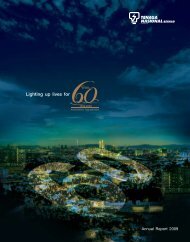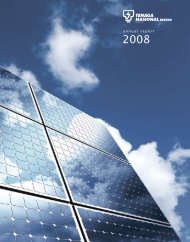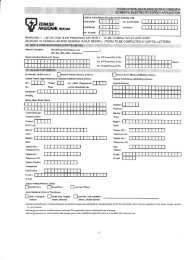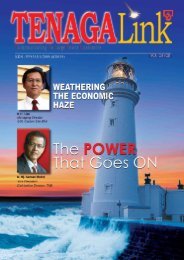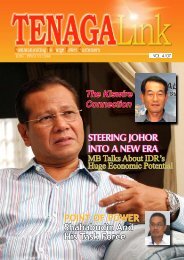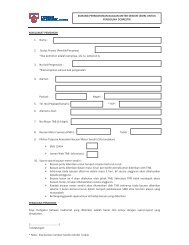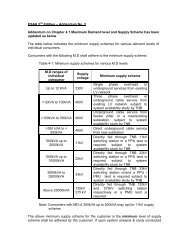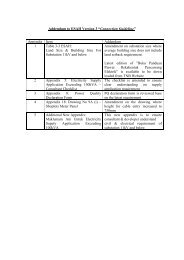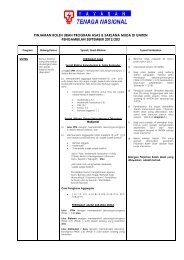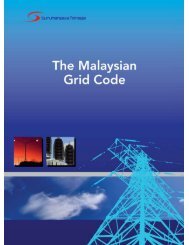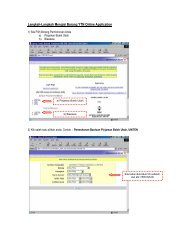You also want an ePaper? Increase the reach of your titles
YUMPU automatically turns print PDFs into web optimized ePapers that Google loves.
KDN : PP8515/1/2008VOL. 02/07IT’S MERDEKA,LIGHT UP!THE BRIGHTESTTORCHYESTERDAYONCE MOREHANDS ONWITH THECUSTOMERSSOLID TIES WITH<strong>LAFARGE</strong>
Profile“As a corporate entity, TNB setstargets and we all give ourbest to achieve them. We liveby standards; which may seema little high; but achievablenonetheless.”TO CARRYTHE BRIGHTESTTORCHTan Sri Datuk Amar Leo Moggie
213YesterdayOnce MoreWe know exactly how we look like today.Bathed in light, bright and vibrant, we are able to take in the sights – clearly, as far as our eyes cansee – of a glorious country before us, most spectacular, especially in the night.But for this to happen – for us to be where we are today – it has taken <strong>Tenaga</strong> <strong>Nasional</strong> Bhd some years.As the country celebrates it’s 50th anniversary, we revisit yesterday, when the lights were just starting tocome on, when the colours were just a shade of what it is today, but nonetheless just as bold and fiery. Wego back to yesterday, when we were young… when there was but a spark…4 5
6871 The Rawang Tin Mine (circa 1894) - old ways give way to anew source of power92 The lantern-like old street lamps at Fort Road, Penang3 The new post war centre of Power - the Connought BridgePower Station in Klang, 19534 & 5 An old Faithful - the Sempam Hydroelectric Power Stationnear Raub... and (right) still at work6 Sharing in the nation’s joy - celebrating the 10th Anniversaryof Merdeka in 1967 by lighting up7 Another kind of co-existence with both gas and electriclighting in Kuala Lumpur - a rare scene in the late fifties8 All in it together at different levels! ‘Team Malaya’ shows theway forward working on pole mounted switchgears in the1950s109 The first Prime Minister, Tunku Abdul Rahman, officiallydeclaring open the NEB10 The spick and span turbine hall of the Bangsar Power Stationprior to decommissioning
Power BitesStrengthening ties with FMMThe management of TNB shared a delightful evening as they dined withthe Federation of Malaysian Manufacturers at the Hilton Kuala Lumpurrecently.Those from FMM who attended include its President Datuk Yong PohKon, Past President Datuk Mustafa Mansur, FMM’s Vice Presidents DatukPaul Low and Dato’ Francis Huang and many others.On the side of TNB, in attendance were TNB’s President/CEO Dato’ SriChe Khalib Mohamad Noh, Vice President (Distribution) Dato’ Ir. AishahDato’ Hj. Abdul Rauf, Senior General Manager (Region 1 – Operations),Datuk Ir. Amir Nordin, Senior General Manager (Region 2 – Operations)Hj. Azman Mohd, General Manager (Customer Services and Marketing)Roslan Ab. Rahman and others.At the event hosted by TNB to foster better ties between TNB andFMM, Dato’ Sri Che Khalib, emphasised the crucial part that operationalexcellence played in fulfilling TNB’s obligation and priority to continuously“Keep The Lights On”.“This is TNB’s core business. A power outage will result in a loss for thecompany as it is for our customers and for the country,” he said.TNB introduces ESAH to REHDAIn an effort to foster better ties with the Real Estate Housing Developers’ Association(REHDA), TNB recently hosted a dinner involving management staff of TNB andREHDA.Those who attended the function, held at the Hilton Kuala Lumpur that night wereTNB Chairman Tan Sri Datuk Amar Leo Moggie, President/CEO Dato’ Sri Che KhalibMohamad Noh, Vice President (Distribution) Dato’ Ir. Aishah Dato’ Hj. Abdul Rauf,Vice President (Transmission) Encik Ab’llah Mohd Salleh, Senior General Manager(Region 1- Operations) Dato’ Ir. Amir Nordin, General Manager (Customer Servicesand Marketing) Roslan Ab. Rahman and many others.As for REHDA, attendees included President Mr. Ng Seing Liong, Immediate PastPresident Dato’ Jeffrey Ng Tiong Lip, Most Recent Past President Datuk Eddy ChenLok Loi; Vice Presidents, Dato’ Fateh Iskandar, Mr Ricque Liew and Mr Ng Lip Chongand others from the management of REHDA.At the dinner, Dato’ Sri Che Khalib informed REHDA members of ESAH, TNB’s 2ndEdition Electricity Supply Application Handbook, which was launched in March. He alsoreminded REHDA of the available Service Level Agreement (SLA) between TNB and HousingDevelopers.He said that with only six agreements signed to date, both REHDA and TNB would have toplay a role in re-educating housing developers nationwide to boost takers.In addition to this, discussions also included the e-application, whereby housingdevelopers will be able to apply for electricity supply on-line via TNB’s website and the threephase metering implementation for selected categories of customers.10Genuine concern for KANEKAHeaded by Dr. Leong Yow Peng, Assistant General Manager(Customer Services & Marketing), TNB officers recentlymade a visit to KANEKA (MALAYSIA) Sdn Bhd in Gebeng,Kuantan, one of TNB Pahang’s Large Power Customers.The visit was part of TNB’s continuous customerservice efforts to ensure that good working relationshipsare maintained between TNB and its clients.Joining the visit was Hj Mohd Rumai Abdullah, GeneralManager TNB Pahang; En Wan Nazmy Wan Mahmood, Headof Unit Power Quality & Energy Efficiency and several otherofficers from TNB Pahang and TNB (Distribution Division)Headquarters, PJ.During the visit, KANEKA’s Managing Director Mr. RyokiTakakuma raised issues faced by the company, mainly onPower Quality vital to KANEKA which is sensitive to voltagedips.An audit was carried out by TNBES right after thevisit. A report by TNBES will be sent to KANEKA to helpthem rectify and invest in suitable PQME that needs to beinstalled in order to reduce the probability of Power Qualityoccurrences to their factory.
Dialogue with Malaysian Plastics Manufacturers AssociationA dialogue was recently held between TNB’s management team and theMalaysian Plastics Manufacturers Association (MPMA). This was an efforton the part of TNB to build good relations with MPMA while trying tounderstand their needs better.It is the first dialogueever held with MPMA.During the dialogue,it was discovered thatthe main issue faced byMPMA was related closelyto power quality. Duringthe session, TNB also tookthe opportunity to enlightenMPMA on power qualityissues and the differentways to manage, mitigateand tackle such incidences.The dialogue, whichlasted about two hours, was held at the Board of Directors’ room, 20thfloor of Wisma TNB, Jalan Timur, Petaling Jaya. TNB management staffwho attended include Vice President (Distribution) Dato’ Ir. Aishah Dato’Hj. Abdul Rauf, General Manager (Customer Service and Marketing)Hj. Roslan Ab Rahman, Assistant General Manager (Commercial Affairs)Hj. Megat Said Megat Ramli, Assistant General Manager (CustomerRelations Management and Marketing) Mr. Leong Yow Peng and others.Meanwhile, representing MPMA were the Association’s Presidentfrom Great Wall Plastic Industries Bhd, Mr. Lim Kok Boon; MPMA’s VicePresident from Sipro Plastics Industries Sdn Bhd, Noraini S Talib; theSecretary-General from Plasform Sdn Bhd, Mr. Eddie Fong and many otherrepresentatives from the various plastic companies in the country.An excellent show!“Excellent! TNB is willing to work hand in hand with us. And they aredefinitely willing to listen. The presentation was very meaningful. It wasexcellent. No more blame to TNB!”These were the comments made by Mr. Bernard George, GeneralManager of Pahang Cement Sdn. Bhd., immediately after listening toTNBES’ presentation on Power Quality Services & Consultancy.The presentation was delivered by En. Wan Nazmy Wan Mahmood, Headof Unit, Power Quality & Energy Efficiency, during TNB’s General Managerof Pahang Hj. Mohd Rumai Abdullah’s PRIME visit to the company.Located in Felda Bukit Sagu 4, Kuantan, Pahang Cement is in the Top10 Large Power Consumers list in Pahang. It is also a member of C&AMalaysia. Currently, Pahang Cement enjoys TNB’s Special Industrial Tariffand has been a good paymaster.During the visit, apart from power quality issues, Pahang Cement hasalso voiced out a few concerns and questions to TNB which would belooked into. The visit ended on a happy note with both sides pleased witheach other for the commitment shown.Fostering better ties with FOMCATNB is always consciously working towards creating greater partnershipsbetween itself and its customers.To further strengthen this bond, apart from site visits to the clients’manufacturing plants and offices, informal gatherings are frequentlyorganised by the power company.Recently, TNB became host to the Federation of Malaysian ConsumersAssociations for lunch. Those from FOMCA were President Mr. N. MarimuthuNadason, Chief Executive Officer Miss Indrani Thuraisingham, DirectorMohd Yusof Abd Rahman and several other FOMCA representatives.As for TNB, it was represented by its Chairman Tan Sri Datuk Amar LeoMoggie, President/CEO Dato’ Sri Che Khalib Mohamad Noh, Vice President(Distribution) Dato’ Ir. Aishah Dato’ Hj. Abdul Rauf and many others fromthe TNB’s management team.The event, held at the Le Meridien, saw Dato’ Sri Che Khalib brieflyexplaining TNB’s 15454 Call Management Centre (CMC). The Centre,he said, had been in operation since 1998, and on June 13, 2006, TNBlaunched its special SMS service.The service, he said, is toenable mobile telephone usersin Malaysia to report electricitysupply interruption and streetlighting failures quickly andat any time. Apart from that,Dato’ Sri Che Khalib said TNB’sfuture plan is to open the SMSchannel for enquiries, billingand other TNB-related mattersto offer more convenience to theconsumer.11
Cover StoryQuestion: Can you tell us some of Lafarge MalayanCement’s high points in the last few years?Alain Crouy: Lafarge Malayan Cement has a history ofmore than 50 years in Malaysia. We were founded in 1950and the first plant started in 1953. Today, we are still theleader in the cement industry in Malaysia, while LafargeGroup, the majority shareholder of Lafarge MalayanCement, is number one in cement worldwide.We have two of the biggest plants in Asia and the world;in Langkawi and Kanthan. A lot of people in the industrywere trained and developed by Lafarge before venturing toother companies.We are also happy with two of our successes; the launch ofthe company’s first differentiated bag product, Avancrete,in 2005 and the launch of a new differentiated bulk product,Mascrete Pro.These are clear indications of our ability to innovate aftervery serious and in-depth customer surveys to determinespecific needs of certain segments of clients in Malaysia.We have come up with these products – more sophisticatedcement - as an answer to their needs.Avancrete is a special cement formula in bags. Contractorsand masons find this product easier to use. It also improvesproductivity; it is able to produce the same quality ofcement at a reduced cost.Mascrete Pro is Lafarge’s pulverised, ash-based cementwhich has the same performance - or better - than ordinarycement, but with more durability. It offers better surfacefinish. We sell this to the industrial users for their pre-castconcrete pieces.In short, we provide a better answer to ordinary Portlandcement.All this has been developed through our R&D with thehelp from the Lafarge technical centre for Asia which islocated right here in Kuala Lumpur.Q:How many cement plants do you own now?A: We have four. Three are integrated cement plants.Cement is a product which is manufactured using stonesfrom quarries. We mix different stones to get the rightcomposition. Then, we go through a burning processin a kiln where we heat that mix to about 1500 degreesCentigrade.What comes out, once cooled, is called klinker. The12
CEMENTING TIESWITH <strong>LAFARGE</strong>When you see more buildings suddenly sprouting out everywhere,changing the Malaysian skyline in the process, you know that thecountry is experiencing growth.Associated closely with this expansion is an industry whichoffers one of the main materials used to erect the buildings,stadiums, houses and such; cement.To get an insight into this industry and a feel of the country’sgrowth through the years, we speak to Lafarge Malayan Cement’sPresident and Chief Executive Officer, Alain Crouy.The Lafarge Group is the biggest producer of cement in theworld while Crouy has been with the company for the past 31years, albeit in other managerial positions in cement plants inFrance and the United States.Who better to pose these questions to, than Crouy, who assumedhis latest positions in July 2004.klinker is then ground in a mill to produce cement whichtakes a grey powder form.We have three plants which do all of these, and one whichdoes only the grinding.The three integrated plants are in Langkawi, Kanthan,which is close to Ipoh, and Rawang. Our grinding mill is inPasir Gudang.Q: Production in Malaysia, how big is it?A: The cement demand in Peninsular Malaysia right nowis between 13.5 and 14 million tons. In the last 10 years,the highest point was in 1997, when it was at 15.6 milliontones, and the lowest was in 1999 at 8.2 million tons.We are still not at the level we achieved in 1997.Q: With the 9th Malaysia Plan and all the projects thatare being rolled out, do you think Lafarge will be ableto do better?A: We hope so. We are quite convinced that growth willresume. For the last three years, the demand for cementin Peninsular Malaysia has been either stable or slightlydecreasing, depending on the year. But we are expectingthe growth to restart very soon and continue into the nextyear.With the start of a number of major projects financed bythe Government and other privately-financed initiatives,we expect the market to move forward again.Q: Who are your biggest export clients?A: At the moment, our main export market is Indonesia,where we export to our sister company Cement Andalas.Cement Andalas used to have a plant in Aceh which waswiped out by the tsunami.Since then, we have been supplying cement to them viashipments from Langkawi. They have become our biggestexport destination, and this is going to continue until theplant is fully rebuilt, which will take another 18 monthsor so.We also export to a subsidiary in Singapore, all the maincountries of the Indian Ocean, Sri Lanka, Bangladesh,Mauritius, Maldives etc.Where is this company heading?A: We are the leaders of the cement industry in Malaysia.13
TNB top management (from left: Roslan, Dato’ Ir. Aishah, Dato’ Sri Che Khalib and Ir. Hj.Hussin Othman) with the Lafarge team.But we want this to go beyond size and capacity. And thisis reflected via Lafarge’s leadership capabilities.We are strong in our safety programmes and aredetermined to be one of the safest companies in Malaysiaand in the world.In terms of customer service in Malaysia, we have showninnovation in our products. We work towards building thebest partnerships with our customers. We demonstrateindustrial efficiency, reliability of our plants, and just asimportant is how we manage our people; the training weprovide, the career development opportunities.We have a university engineer-recruitment programmewhere we go to universities and recruit engineers whomwe put through very intensive training programmes todevelop and build them into the managers of tomorrow.So, it’s all these aspects.We are the biggest, fine. But we want also to be thereference for the cement industry and eventually theindustries of the world.Our values are, respect, care and action. And that’s howwe want to continue to build this company and as far asthe cement industry is concerned, we want to contributein building a sustainable stability for the industry and helpbring the industry to a fair level of profitability.Q: Can you tell us Lafarge’s power consumption in amonth?A: We consume approximately 85 million kWh per monthat a cost of about RM18 million a month.In 2006 we used 1.1 billion kWh. That would be a fewhundred million ringgit. Five years ago, in 2001 we used870 million kWh.We are basically running at full capacity. And thiscapacity is increasing a little bit every year as we improveour efficiency.Consistent power supply is vital. We are running ourplants 24 hours a day, seven days a week, 365 days a year.14Any power interruptions will stopour kilns and hundreds of electricmotors which run 24/7.When the kiln stops, we willhave to restart them. When thepower comes back, it will starteasily or not depending on theincident. The kiln can stay downfor one hour, two hours, threehours, 24 hours or 48 hours.Anytime the kiln stops, beforestarting it again, we have to reheatit. If the stoppage is short, thereheating process will be short. Ifit is a few hours, then the reheatingprocess would take longer. Duringthis reheating period, there is notproduction, it’s all cost before youare able to start production.The kiln is the heart of the plant.We take the number of stoppagesvery, very seriously. An hour ofkiln stoppage will cost us about RM50,000. Fortunately,this doesn’t happen very often.Q: Are you happy with TNB’s services?A: Yes! We have seen a significant improvement in the pasttwo to three years in terms of relationship and technicalservice. We feel that today, TNB has a real concern for usas a customer.TNB understands that dialogue, regular contact,discussions are key to problem solving and is prepared toanticipate problems and schedule downtime etc.Before, the relation was more formal. Now, we arebeginning to build a partnership in working together.To anticipate and solve problems together. The recentvisit to our Rawang plant on June 19 by the Presidentand CEO, Dato’ Sri Che Khalib Mohamad Noh and VicePresident, Distribution Division, Dato’ Ir. Aishah Dato’Hj Abdul Rauf and the TNB staff, is a sign that somethinghas changed.As for the relationship at the regional areas where ourbranches are, there has also been tremendous improvement.“We have seen a significantimprovement in the past two tothree years in terms of relationshipand technical service. We feel thattoday, TNB has a real concernfor us as a customer. At theregional areas there has also beentremendous improvement. Fantasticco-operation.”
Fantastic co-operation.But of course, there is still always room for even moreprogress.Q: Can you tell us about your commitment to sustainabledevelopment and the environment.A: The Lafarge Group, the mother company, has alwaysbeen very dedicated to sustainable development, waybefore this expression existedsome 10 years ago.We look at sustainabledevelopment in differentaspects, one of which is in therespect and care for our staff, aswell as the safety of our users.The Lafarge Group isalso engaged in worldwideprogrammes like the fightagainst HIV/AIDS. We arealso trying to develop thepresence of more women insenior management levels ofthe country.In terms of the environment,we run very systematicenvironmental audits in allour plants. We have signedan agreement with the WorldWide Fund for Wildlife. Andwe are constantly working towards the reduction of fuelemissions.We do this in three main ways; the first way is to improvethe system in our kilns via optimisation or modernisation.The second way is to burn waste instead of fossil fuels.We use several million tons of waste.We are also promoting the use of products which areactually by-products of other industries. This results inthe need for less klinker for the same quantity of cement,resulting in less carbon dioxide emissions.The Lafarge Group is also in partnership with the WorldBusiness Council for Sustainable Development. We are alsothe co-founder of the CementSustainability Initiative andhave grouped 18 of the biggestcement companies in the worldfor this purpose.In addition, the LafargeGroup has been included forthe third year running in theglobal list of the top 50 MostSustainable Operations in theworld.Lafarge Malayan Cementfollows suit. We are committedto the Group’s causes. Wehave a high commitment insafety and health issues and areconducting programmes in ourplants as well as on the road.We train our employees – contractors, transporters andthe drivers and build partnerships to improve the safetyculture and mindset of everyone working with us or for us.We invest a lot in internal communications. We havea vision and we need to communicate it to people; tomotivate them and get them to participate. We have a highinvestment in training whether technical or managerial.In terms of the environment, we share the sameenvironmental audits and the same carbon dioxide reductionprogrammes that the Lafarge Group is committed to.We are also members of the Business Council forSustainable Development Malaysia and I am the President ofthe Environment Committee of the Malaysian InternationalChambers of Commerce Industry (MICCI)It’s all about respect, care and excellence. And when wetalk about care, we are thinking of a whole category ofpeople; our four main stake holders, customers, employees,the communities in which we live and our shareholders. Wecare for each party differently, but basically it stems fromthe culture we want to develop.15
In The NewsTowards Better Understanding Of Customers’ Energy Usage<strong>Tenaga</strong> <strong>Nasional</strong> <strong>Berhad</strong> (TNB) is looking to improveits revenue and operational efficiency through theimplementation of Remote Meter Reading (RMR) systemsfor its large power consumers.Vice President for Distribution Dato’ Ir. Aishah Dato’Hj. Abdul Rauf said the RMR systems would enable TNBto better understand the consumption and energy usagepatterns of its commercial and industrial customers.“We will be able to obtain a very detailed profile ofthe (customer’s) load, which our current metering systemcannot do. TNB will also be able to better manage powergeneration, as it would be able to analyse its customers’usage patterns and load profiles.”Aishah said this at the contract handling-over ceremonyand software licensing agreement between TNB, ImpianasSdn Bhd and Itron International recently.She said the scope of the project wasto design, supply, deliver, install, testand commission a commercially provenRMR system that would cover 60,000low voltage large power consumerswhose meters would be read centrallyat one Central RMR Data CollectionCenter.Aishah said Impianas and Itron’ssoftware were chosen partly due to theirtrack record of having done the first pilotproject of 1400 remote meter reading in2002.In mid 2002, TNB began implementingthe RMR project for 2,000Large Power Consumers(LPC). Basically, theelectronic meters installedat the LPC premises isconnected via wirelessradio known as Radio-PAD (RPAD) to the RMRSoftware known as MV90at TNB Metering inPetaling Jaya.The software remotelyinterrogates the meterusing the wireless packetswitched network toretrieve data from themeter. Two types of dataare retrieved daily, i.e.half-hourly interval data and the register data. Impromptuor ad hoc calls can be made to retrieve the metering dataat anytime of the day.The three main objectives to this project was to providemonthly meter readings taken remotely using wirelessnetwork and MV90 software for billing purpose; providedaily, weekly and monthly data analysis for the detectionof the data irregularities; and notification of event failure.Aishah said 70 per cent to 80 per cent of TNB’s revenuestemmed from its commercial and industrial customers.Itron provides solid state meters and data collection/communication systems, including automated meterreading and advance metering infrastructure technology.The company will be assisting Impianas with softwaresolutions.In agreement: (From left) Doug Staker , VP Itron International; Dato’ Ir. Aishah, VP TNB Distributionand Muhammad Fadil Helmi Abd. Karim, GM Impianas.16
RegionalTNB’s Region 2 Senior GeneralManager, Ir. Haji Azman Mohdsheds some light on his job; on“powering” seven states; and howTNB is continuously working tokeep things bright and happy forclients under its charge.Hands onwith theCustomers<strong>Tenaga</strong> <strong>Nasional</strong> <strong>Berhad</strong> (TNB), the largestelectricity utility company in Malaysia, isone company that will not pull the plug onits customers.To begin with, there are about 6.5 million users to answerto and furthermore, one of its battle cries is quite simply,Keep The Lights On.In fact, its Region 2 Senior General Manager, Ir. HajiAzman Mohd is happy to furnish us with more mottos thatthe establishment adhere to like The Faster We Connect,The Faster We Collect, Stop The Bleeding.The latter translates to an ongoing effort by TNB to keepits services as efficient as possible and Azman who headsthe distribution side in seven states namely Perlis, Perak,Kedah and Penang in the north and Kelantan, Terengganuand Pahang in the East Coast, believes it does deliver.Firstly, TNB is clear about its directions; it wants to move itsoperations and services to a higher plane and be among thebest in the world. “To do this, we need to be hands on aboutcustomers’ requirements and we are making headway.”TNB is clear about its directions; itwants to move its operations andservices to a higher plane andbe among the best in the world.“To do this, we need to be handson about customers’ requirementsand we are making headway.”17
To achieve this end, the company hassegmentised its customers into twomain groups namely Prime customers(key account customers and verylarge power users) and ordinarycustomers.An example is Kuala Tembeling,Pahang which sees TNB concentratingmore on vegetation management.“This is when we clear thick junglesand undergrowth and fix long lines tobring electricity.”In terms of improving services, TNBhas not been sluggish. Some majorprojects going on in Region 2 Perakinclude the 22kV Conversion Projectwhich is an upgrading exercise ofTNB lines.There is also the cultural difference inthe urban and rural spots to observe.“In an advanced place like Selangor,the momentum of progress is fast. Inthe East coast states, the pace is morerelaxed and expectations are different.”The issues arising from the differentstates also vary. For instance, thecustomers in a progressive state likePenang (like in Selangor and Johor)are mostly concerned about powerquality as opposed to reliability whichthey already enjoy.In spots like Pahang, Kelantanand Terengganu, one encounters amixed bag of issues because of thegeographical factors like vast junglesand sparse population. Among otherthings, expensive infrastructure isrequired here.18For a fast developing industrial arealike in Pahang’s Gebeng, where alarge portion of their high-poweredcustomers are also located, TNBwalks the extra mile by sending aspecial task force to ensure highquality power.“Currently, we are trying to‘educate’ state authorities on thediffering requirements of the variousindustries,” he discloses. “We wantthem to properly azone or align them,so we could enhance our services.”TNB has never been busier. “Thesedays, all states are coming up withcyber centres or cities. This is theway forward and to keep in step, thereare certain investments we need todo then to really push our reliabilitylevel.”In Pahang, there is the CrystalProject which has potential SCADAcapabilities for long 33kV linesenable faster fault restoration times,better planning and operations.“These days, all statesare coming up withcyber centres orcities. This is the wayforward and to keepin step, there arecertain investmentswe need to do thento really push ourreliability level.”Two currently exciting projects inTerengganu are the renewable energyprojects of Pulau Kapas and Pulau
Perhentian. TNB has successfullycompleted the Solar Hybrid projectin Pulau Kapas helping to reduceemissions from generating dieselsets supplying electricity to the resortoperators. One of the first Wind/SolarHybrid project of its kind in thisregion will be the Pulau Perhentianproject which is due to complete thisyear’s end.One of the most important projectin the Operation’s Region 2 states iscurrently the SCADA project. With acentralised control centre located inSeberang Prai, Penang the NERCC(North & Eastern Regional ControlCentre) will improve operations andrestoration time of the network.To see to the efficient implementationof these programmes, Azman believesthat human resource is the key. “Forme, it is still about people; we aregetting our people to move faster. Weare investing in capacity building, wewant to make our people competentand more knowledgeable.”“We’re spending a lot of time withemployees at all levels from those insupervisory positions to area managers,supporting staff and general managers.We need to ensure we are all talking inthe same language,” he enthuses.One of the 49-year-old’s key tasks is tosee that while the staffers in the otherstates can work independently, theyhave to be attuned towards TNB’s goal.“So my people meet for regularmeetings to discuss issues, old andnew, assess what needs fast responsesTNB has introducedmany programmes.One is the Prime VisitCustomer programmewhere officerspersonally visit keycustomers themselvesand get acquaintedwith the problems theymight have.and so forth,” he says, adding thaton a day to day basis, there are alsotroubleshooting and interacting withcustomers to do.According to him, there is a tight knitcontrol system in relation to the KeyPerformance Indicator devised tomonitor progress. “Everybody knowsthey have the resources, so they onlyneed to implement them well.”“We keep tabs on how they performand should there be hiccups, we takepains to find out whether the issue istechnical, methodological or so on.”Meantime, to forge better customerrelations, TNB has introduced manyprogrammes. One is the Prime VisitCustomer programme where officerspersonally visit key customersthemselves and get acquainted withthe problems they might have.“It is surprising what you might findout and be able to provide when youspeak to them personally. It goes toshow that we cannot just sit in ouroffices and indeed, we cannot lumpour customers in one big mass by wayof requirements.”TNB has another corporate programmecalled the Community LeadershipOutreach Programme (CLOP) whichsees its officers interacting with MPs,wakil rakyats and community leaderson electricity matters.But what remains a crucial customercontact point is, of course, its Kedai<strong>Tenaga</strong>. “On top of that, we do anationwide customer survey indexwhich gives us a good indication ofwhere we stand with our clients,” saysAzman who joined TNB (then calledLembaga Letrik Negara or LLN) asan engineer at its Mentakab, Pahangoffice in 1979. Since, he has gonethrough the ranks, from a promotionto District Manager in Rawang to asimilar post in Kajang.He then moved from General Managerof the Perlis office to being StateGeneral Manager in Selangor. Priorto his present position, he was madethe GM of Strategic ManagementAnd Organisation Development inthe main office.Azman is proud to be with TNBwhich he believes is one of the bestorganisations in the world. “Whatmakes it attractive is that one getsa chance to contribute to society.Electricity is required by all and to beable to use one’s expertise to serve tothis end is fulfilling.”From the waves he is making, it mightbe no exaggeration to say that thisdedicated man may also be one of itsbrightest bulbs...19
Light up for Merdeka!It’s that time of the year again where TNB invites you to literally light up!Merdeka is here. What’s more, it’s our 50th year of independence; a good enough reason to celebrate big time!Herein lies a once-in-a-lifetime chance to truly colour the city with a show of <strong>Tenaga</strong>! Power up your buildingswith a spectacular show of bright hues. Light the town red, or blue, or green, or yellow… light it in the colours of therainbow.Flood the city we love with the glitter, sparkle and shine of bulbs that will not just dazzle us in an awesome display,but the tourists that are here during this period, which coincides with Visit Malaysia Year.To add cheer to the pomp and festivities, between July and September 2007, TNB is gladly offering it’s SinaranMerdeka Incentive, which is open to all commercial customers such as high rise buildings, office blocks, commercialcomplexes, shopping complexes, hotels, petrol stations etc, currently under B, C1 and C2 tariff categories.The special rates for the three months, will be extended to consumers who had their power installed before October2006 and with at least one Normal (N) reading during the April, May or June 2007 billing.Customers will be charged at 13.4sen/kWh for additional increase of power usage during the period, taking intoaccount the average power usage for April, May and June 2007.This incentive will be calculated automatically by the Electronic Customer Information Billing System on October2007 via the Station Billing System (work order 64). Each application should be registered under the e-CIBS systembetween August 15 and September 30, 2007.



